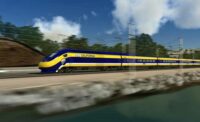

In August 2008, Caltrans and its joint venture general contractor DeSilva Gates/Flatiron West Inc. broke ground on the $325 million Lincoln Bypass project, which will create an 11.7-mi bypass around the city. The project received $162.9 million in Proposition 1B funds, the $19.9 billion transportation bond approved by voters in 2006. Other funding is coming from the city, Placer County, the South Placer Regional Transportation Authority and the federal government.
The northern segment of State Route 65 begins at the interchange with Interstate 80 in Roseville as a freeway heading northwest to Blue Oaks Boulevard where the freeway turns north towards Lincoln. The freeway currently ends south of the Sunset Boulevard intersection in Rocklin where the highway continues as a four-lane expressway. The highway is then reduced to roughly two lanes as it enters downtown Lincoln. The highway heads northwest again outside of Lincoln as a rural two-lane highway, passing through the communities of Sheridan and Wheatland. It assumes its freeway designation a few miles north of Wheatland, ending at State Route 70 in Olivehurst.
The Lincoln Bypass project will entail two phases -- Phase 1 includes adding four lanes for the bypass between Industrial Avenue and Nelson Lane, and two lanes further north to the town of Sheridan; and Phase 2 includes adding two additional lanes between Nelson Lane and the town of Sheridan, and adding interchanges.
Sam Jordan, P.E., Caltrans project manager, says that the existing facility through Lincoln is a “Main Street” highway, which will not serve the ultimate transportation needs of the region.
“Due primarily to congestion, the collision rate in downtown Lincoln is higher than the statewide average rate for this type of facility,” he says. “The purpose of the project is to relive congestion and improve safety on existing State Route 65 in the vicinity of the city of Lincoln and provide for a regional traffic solution to accommodate projected traffic volumes for the year 2025.”
Jordan says the bottlenecks in the city are exasperated by “flooding issues,” as well as a number of signalized intersections and at-grade railroad crossings.
One of the main elements of the project is the construction of 17 bridges, all of which will be built on site.
Jordan says the bypass goes through “developed, undeveloped and farm land areas.” It crosses, in order, Industrial Boulevard/Union Pacific Railroad, South Ingram Slough, Ferrari Ranch Road, North Ingram Slough, Auburn Ravine, Markham Ravine, Nicolaus Road Overcrossing, Lincoln Airport Creek, Coon Creek, North Farm Overcrossing, South Yankee Slough, North Yankee Slough and Big Yankee Slough.
The project will also include six soundwalls, a partial interchange at Industrial Boulevard and a full interchange at Ferrari Ranch Road, and three at-grade intersections at Nelson Lane, Wise Road and Riosa Road.
Construction is scheduled to be completed in fall 2012.
Earlier this year, there were discussions in the capitol about freezing a number of budgets for a number of statewide highway projects, due to the financial meltdown nationally and the state’s inability to pass an annual budget.
Jordan says that although the Lincoln Bypass project was considered in the freeze, “We got lucky and dodged the bullet.
“The state budget challenge did not impact this project because Prop 1B and local funds continued to carry the project.”
Overally, Jordan says the project is moving ahead swimmingly.
“We are very fortunate to have excellent staff administering this project and also a good contractor to work with,” he says. “It’s a continuous team effort between Caltrans employees and management and the GC’s employees and management. We have plans for everything -- communication, emergency, contingency. Our field personnel meet with the contractors daily, weekly, monthly and quarterly in an effort to stay on top of things and to insure safe and smooth operations.”


